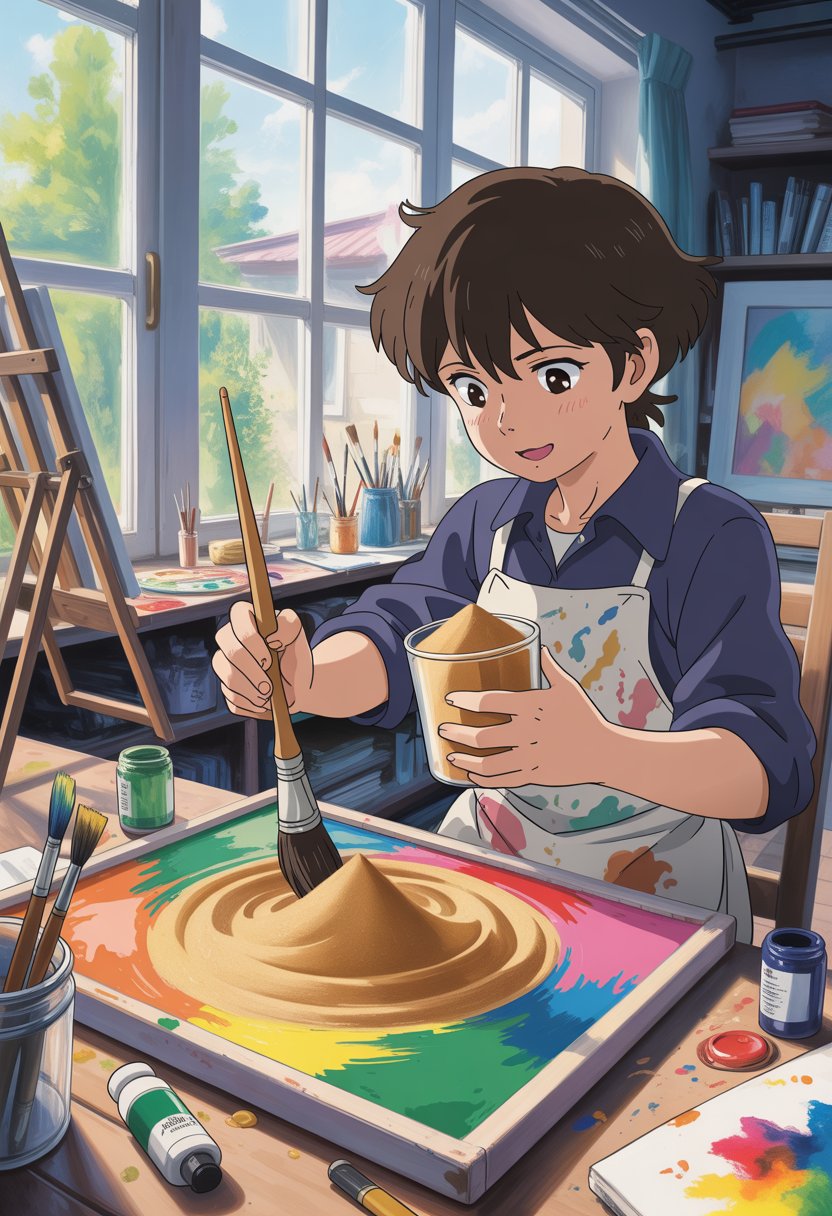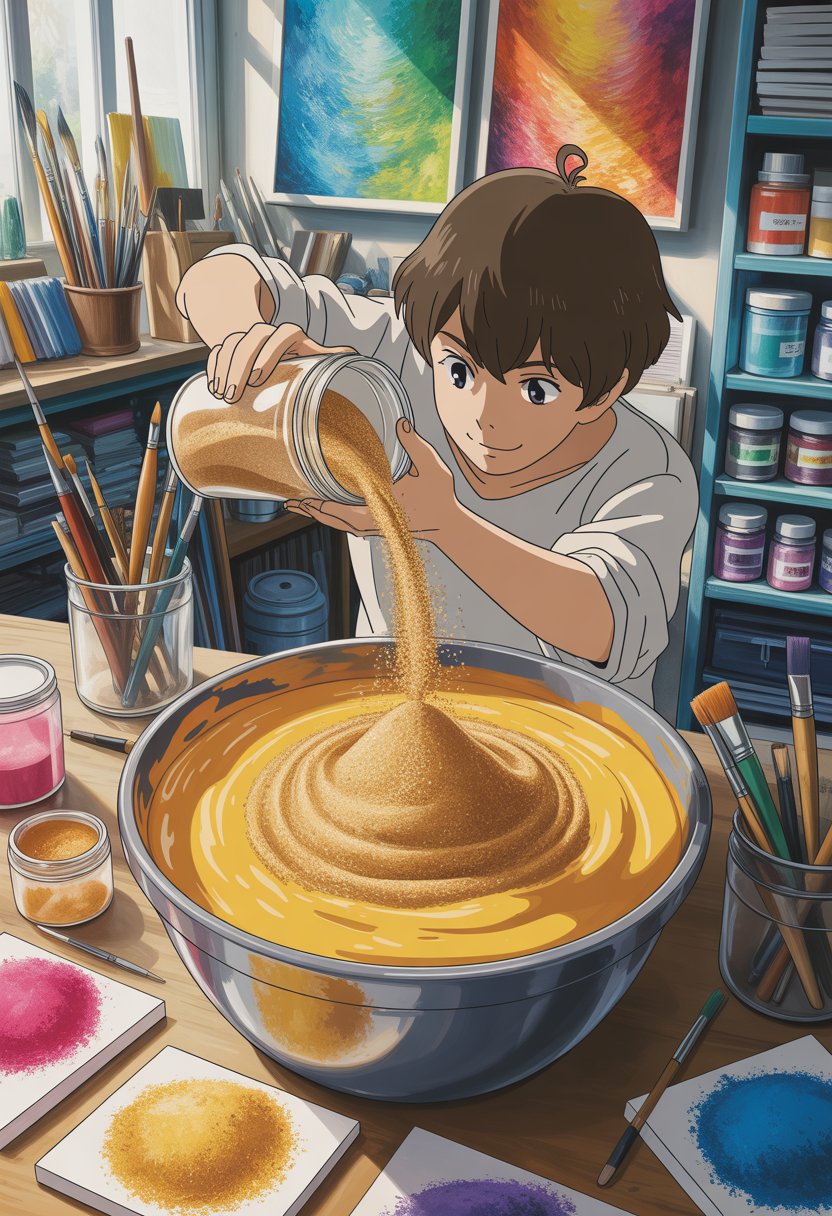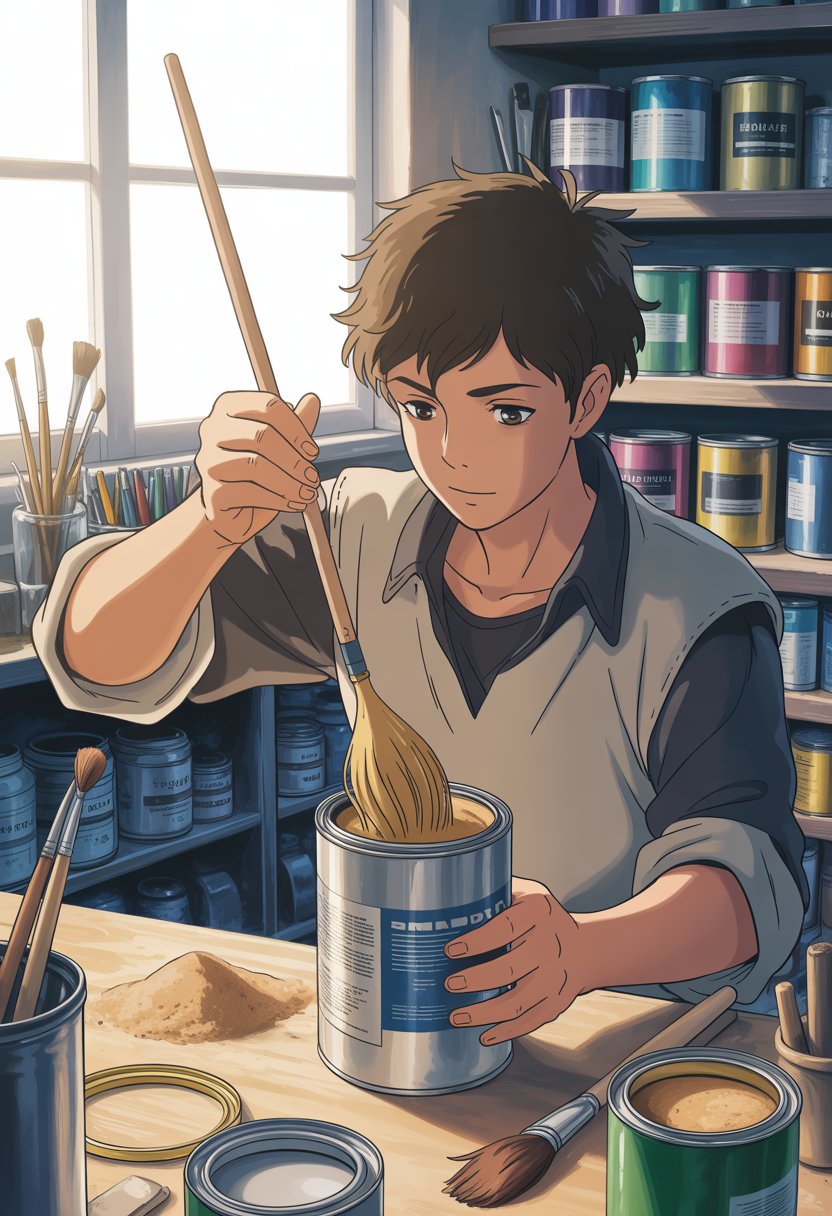How To Add Sand To Paint: Create Textured & Non-Slip Surfaces
Adding sand to paint is a surprisingly straightforward way to create textured surfaces and make areas around your home less slippery. You can use this trick indoors or out—maybe you want to add grip to slick steps or just spice up a wall with some texture. Either way, it’s a handy DIY move.

For most projects, mix sand straight into paint at a ratio of four parts paint to one part sand. It’s easy, budget-friendly, and honestly, it saves you from buying those overpriced textured paints. You just need to pick the right sand and paint for the job.
Get the Fail-Safe Paint Color Playbook (Free PDF)
36 proven colors • 8 ready palettes • trim & sheen guide • printable testing cards.
This guide covers everything from picking out your materials to actually painting with your sand-mixed paint. I’ll go over which sands and paints work best, plus a few maintenance tips. Whether you’re trying to stop slips on outdoor stairs or just want to give your walls some personality, you’ll find what you need here.
Benefits of Adding Sand to Paint

Mixing sand into paint gives you a textured, non-slip finish that’s both practical and easy on the wallet. It’s a go-to for better traction outside and for adding a bit of visual flair to walls, decks, and more.
Enhanced Traction and Safety
When you use sanded paint, you get a much grippier surface, especially on wet days. Slippery steps and decks? Not so much of a problem anymore.
Rain or snow turns outdoor surfaces into skating rinks. But with sand in your paint, you get tiny bumps that help your shoes grip. This is a game changer for:
- Porch steps and stairs
- Wooden decks and patios
- Concrete walkways
- Pool areas
Coarser sand means more grip. Play sand is usually a good pick since it’s clean and textured just right. Your painted surface stays safer, even when wet.
Slick concrete? Add sand and you’ll notice a big difference in safety. It’s honestly one of the simplest fixes out there.
Aesthetic Texture and Design
Sand in paint isn’t just about safety—it can make things look cool, too. You get a subtle, grainy texture that hides little wall flaws and gives surfaces a bit more character.
The sand leaves tiny specks and a gentle roughness in the finish. You control the look by adjusting how much sand you mix in. Want bold texture? Add more sand. Prefer it subtle? Use less.
Some ideas for where textured paint shines:
- Interior walls – Masks small dents and dings
- Exterior surfaces – Adds curb appeal
- Ceilings – Breaks up the monotony
If the speckled look is too much, you can always do a second coat without sand. That’ll soften things up while keeping some texture.
Cost-Effectiveness Compared to Other Solutions
Let’s be real: adding sand to regular paint is way cheaper than buying specialty non-slip coatings. A bag of play sand costs just a few bucks and lasts for ages.
Quick cost breakdown:
- Commercial non-slip paint: $40-60 per gallon
- Regular paint + sand: $25-35 per gallon
- Non-slip strips: $2-4 per linear foot
You save a chunk of money and get basically the same results. Plus, it’s all stuff you can find at any hardware store.
Get the Fail-Safe Paint Color Playbook (Free PDF)
36 proven colors • 8 ready palettes • trim & sheen guide • printable testing cards.
No need for fancy products or hiring someone else—just use what you already have and get to work.
Choosing the Right Sand for Paint
Your sand choice actually matters a lot. Silica sand is usually the winner, and the grain size sets the tone for your texture.
Silica Sand Vs. Play Sand
Silica sand is the gold standard for this kind of project. It’s made from quartz, super clean, and the grains are nice and consistent—so it mixes in easily.
You’ll find silica sand at most hardware stores, and you can choose from fine to coarse. Play sand is okay in a pinch, but it’s not perfect. Play sand can be dusty or have weird bits mixed in that don’t blend well with paint.
Why silica sand?
- Clean, pure grains
- Blends evenly into paint
- Available in different textures
- Doesn’t clump or streak
Play sand sometimes leaves your paint looking patchy, and it can even mess with how the paint sticks. I’d skip it if you have the choice.
Grain Size and Coarseness
Sand grain size changes everything. Fine grains give you a soft, understated texture. Coarse grains make things bolder and rougher.
Fine sand is best for:
- Walls and ceilings inside
- Gentle, subtle texture
- Just a bit of extra grip
Medium sand works for:
- Moderate wall texture
- Light traction outside
- General DIY projects
Coarse sand is for:
- Strong, gritty texture
- Maximum grip on slick spots
- Really bold finishes
Want a soft look? Go fine. Need some serious grip or drama? Grab the coarse stuff. It’s your call.
Get the Fail-Safe Paint Color Playbook (Free PDF)
36 proven colors • 8 ready palettes • trim & sheen guide • printable testing cards.
Avoiding Impurities in Sand
Clean sand is non-negotiable. Dirty sand (with clay, salt, or bits of leaves) can mess up your paint job.
Beach sand might sound tempting, but don’t use it. Salt damages paint and you’ll end up with shells and junk in your finish.
Skip sandbox or backyard sand, too. They’re usually full of dirt and random debris.
Bad sand warning signs:
- Dirty appearance or dark patches
- Twigs, leaves, or other stuff mixed in
- Feels extra gritty or odd
- Smells funky
Just buy your sand from a hardware or paint shop. It’s cleaned and made for projects like this. The small extra cost is worth not ruining your paint.
Selecting the Ideal Paint for Sand Addition

Picking the right paint makes a big difference when you want texture or non-slip power. Latex and waterproof paints are the go-tos. Some paint types just don’t play nice with sand—they get runny or lumpy, and nobody wants that.
Best Paint Types for Sand Mixing
Latex paint is kind of the MVP here. It keeps its texture even with sand mixed in and sticks well to most surfaces.
Waterproof paint is another good choice, especially for bathrooms or outside areas that get wet a lot.
Floor paint is worth considering for high-traffic spots. It’s made to handle lots of footsteps and the sand bonds right in.
Get the Fail-Safe Paint Color Playbook (Free PDF)
36 proven colors • 8 ready palettes • trim & sheen guide • printable testing cards.
| Paint Type | Best For | Key Benefits |
|---|---|---|
| Latex | Interior walls | Easy cleanup, good adhesion |
| Waterproof | Wet areas | Moisture resistance |
| Floor paint | High-traffic areas | Durability, slip resistance |
Oil-based paints? Not great for this. They tend to get too thin and don’t hold the sand well at all.
Considerations for Interior and Exterior Paints
Interior and exterior paints have different needs when you add sand. Indoors, you want something easy to apply and not too rough to touch.
Textured paint inside should use fine silica sand. That way, you get some texture but nothing scratchy if you brush against the wall.
Outside, paints need to stand up to the weather. Look for something with strong adhesion so the sand doesn’t wash away in rain or crack in the sun.
Sand-mixed exterior paint is a favorite for decks and steps—keeps things safer and protects the surface, too.
Finish matters as well. Flat, eggshell, semigloss, or gloss all work with sand. Just choose what fits your cleaning habits and style.
Acrylic Paint Characteristics
Acrylic paint is a solid pick for sand mixing. It dries fast and bonds well with the sand, which helps keep everything in place.
It stays flexible after it dries, so your textured surface is less likely to crack if things shift or expand.
Acrylics are water-based, so cleanup is a breeze—just soap and water, no harsh stuff needed.
The quick dry time means the sand won’t just sink to the bottom while you’re working. That keeps your texture nice and even.
Sand-mixed acrylic paint covers well. Usually, two or three coats are enough for good sand coverage.
Step-By-Step Guide: How To Add Sand To Paint
Getting sand into paint isn’t complicated, but you do want to prep right, use the right ratio, and mix well. Clean sand is a must. Start with four parts paint to one part sand, then tweak if you want more or less texture.
Preparing the Painting Surface
Good prep always pays off. Scrape away any loose or flaky paint first—just use a scraper or wire brush.
Give the area a quick sanding so you’ve got a smooth base. That helps the new paint stick and keeps it from peeling.
Wash everything down with soap and water, then let it dry completely.
If you’re painting bare wood or metal, slap on a primer. Especially with sanded paint, you want that extra grip so the texture doesn’t pull away over time.
Why prep?
- Paint sticks better
- Finish lasts longer
- Texture goes on evenly
Mixing Sand with Paint: Ratios and Tools
Start with a 4:1 paint-to-sand ratio. Only use clean sand, like play sand or silica from the hardware store.
Beach sand or dirt? Don’t even think about it. Salt and debris will wreck your paint and leave you with ugly clumps.
Pour your paint into a mixing bucket. Add the sand a bit at a time, stirring constantly with a paint stick or a mixer attachment on a drill.
It’s smart to mix small batches at first—try a quart of paint with 1/4 cup of sand. Keep stirring as you go, since sand settles fast.
Remix every few minutes while painting. Sand likes to sink, so don’t let it sit too long between coats.
Testing and Adjusting Texture
Try your mixed paint on a small test spot before tackling the main surface. A corner or scrap piece of wood works fine.
Let the test patch dry all the way. See how grippy it feels and take a close look at the texture.
Too rough? Dial back the sand—try a 5:1 or 6:1 ratio.
Not enough texture? Add more sand, maybe up to a 3:1 ratio.
Experiment with ratios until you get the feel you want. Ideally, it should feel grippy but not scratchy on bare skin.
When you’re satisfied, scale up the mix using that ratio. Foam rollers or short-nap rollers usually give you the most even finish.
Application Techniques and Best Practices
Getting a smooth look with sand in your paint really depends on your tools and technique. Stir often and stick to thin, even coats to avoid clumps and keep the texture consistent.
Applying Sand-Infused Paint Evenly
Break the surface into manageable sections. It’s easier to control, and you’ll avoid spots drying at different rates.
Stick with thin coats. Thick layers just let the sand settle and make things look lumpy.
Brush or roll in one direction first, then lightly cross over. This helps spread the sand around more evenly.
For vertical surfaces:
- Work top to bottom
- Use light, overlapping strokes
- Keep a wet edge so you don’t get lap marks
For horizontal surfaces:
- Go from one end to the other
- Use long, smooth strokes
- Check for missed areas while it’s still wet
Try not to overwork the paint. Too much brushing just makes the sand clump together.
Stirring and Maintaining Consistency
Sand drops to the bottom pretty fast. Give your paint a good stir every 10-15 minutes to keep things mixed up.
Use a figure-eight pattern when stirring. It pulls sand up from the bottom better than just going in circles.
Don’t forget to scrape the sides and bottom of your bucket now and then. Sand loves to stick there and won’t mix back in unless you help it along.
Signs you need to stir again:
- The paint looks runnier than when you started
- Surface texture is fading
- You can see sand building up at the bottom
If it gets too thick, add a little paint—not water, or you’ll risk separation.
Keep your brush or roller damp, just not dripping. Dry tools tend to pull the sand right out of the mix.
Recommended Application Tools
Natural bristle brushes usually work best for textured paint. They grab onto the sand and spread it out evenly.
For most jobs, 3-4 inch wide brushes hit the sweet spot. Use smaller ones for corners and details.
Best brush types:
- China bristle brushes for oil-based paint
- High-quality synthetic for water-based paint
- Chip brushes if you want a rougher look
Rollers with a 3/4 inch nap can handle the grit. Shorter naps just don’t pick up enough of the textured paint.
Skip foam rollers—they squish under the sand’s weight and leave streaks.
Clean your tools often as you go. Sand builds up and makes them less effective pretty quickly.
Try a paint grid instead of a tray. Grids help the sand get onto your roller more evenly and stop it from settling at the bottom.
Usage Scenarios and Creative Ideas
Adding sand to paint? There’s a lot you can do—practical and creative. It’s great for safer walkways, giving walls a bit of flair, or just making your paint more interesting.
Making Non-Slip Surfaces for Safety
Sand in paint makes a classic non-slip finish for decks, stairs, and walkways. Those tiny bumps give your shoes extra grip, which matters when things get wet.
Mix sand into floor paint for basement steps or garage floors. Slippery spots become a lot safer with a little texture.
Silica sand’s your best bet. Beach sand’s tempting but full of salt and debris that can mess up your paint. Hardware stores usually stock clean silica in various sizes.
Here are some starting ratios:
- Light texture: 1 part sand, 3 parts paint
- Medium texture: 1 part sand, 2 parts paint
- Heavy texture: 1 part sand, 1 part paint
Pool decks and boat ramps really benefit from extra grip. Sand in marine paint does wonders for safety around water.
Textured Finishes for Walls and Ceilings
Want to hide wall flaws or just add some character? Sand-textured paint can do both. A touch of fine sand gives a subtle texture that beats flat paint any day.
Light sand textures look great on interior walls. The surface catches light in interesting ways and adds depth. Works nicely in living rooms or bedrooms, honestly.
Ceilings? Sand texture helps disguise cracks and imperfections that smooth paint can’t hide.
Different sands, different looks:
Get the Fail-Safe Paint Color Playbook (Free PDF)
36 proven colors • 8 ready palettes • trim & sheen guide • printable testing cards.
- Fine sand = smooth, gentle texture
- Medium sand = more pronounced bumps
- Coarse sand = bold, rough finish
Accent walls pop with sand texture. Pick a single wall and go textured; keep the rest smooth for contrast. It draws the eye but doesn’t overpower the space.
Decorative and Artistic Projects
Sand opens up a bunch of creative options for art and crafts. Mix colored sand into clear paint for one-of-a-kind textures.
Old furniture looks fresh again with sand-textured paint. Tables, chairs, cabinets—all get a new vibe, and the texture covers up scratches and dings.
Artists sometimes add sand to acrylics on canvas. The texture gives paintings more depth and plays with light and shadow.
Want ideas?
- Outdoor planters: Sandy texture looks right at home with plants
- Picture frames: A little texture makes them stand out without being too much
- Cabinet doors: Medium texture hides fingerprints and daily scuffs
Exterior walls can use sand for a rustic, natural vibe. It goes well with stone, brick, or wood, and tends to hold up better against weather than smooth paint does.
Care and Maintenance of Sand-Textured Surfaces
Sand-infused paint needs regular cleaning with gentle methods and a bit of care if you need to touch up. With the right approach, your textured finish can last for years—even in busy spots.
Cleaning Recommendations
Dust or vacuum sand-textured surfaces often with a soft brush. Texture traps dirt more than smooth paint, so a little routine effort goes a long way.
For a deeper clean, mix mild detergent with warm water. Use a soft-bristled brush and just work gently. Skip harsh chemicals—they’ll damage the paint or loosen sand.
Got stubborn stains? Try this:
- Scrub gently with a soft brush in circles
- Wipe away cleaner with a damp cloth
- Let the surface air dry
No abrasive cleaners or steel wool—those will pull sand right out and ruin the texture. Power washers? Maybe for exteriors, but never inside and only with care outside.
Weekly dusting helps keep grooves from filling up with grime. A microfiber cloth or a soft vacuum brush works fine for this.
Touch-Ups and Repairs
Small chips or scratches? Use leftover sand-textured paint to fix them up. Save some of your original mix for this purpose if you can.
Mix fresh sand into matching paint at the same ratio as before. Dab it onto the damaged spot with a small brush and try to blend it into the surrounding texture.
For bigger repairs:
- Clean the area first
- Sand off loose paint
- Prime if needed
- Brush on your sand-paint mix
- Let each coat dry before adding another
Test your color match in a hidden spot first. Paint colors fade, so old and new might not match perfectly.
If the texture’s thin, press some extra sand into the wet touch-up paint. That keeps the look and slip-resistance consistent.
Long-Term Durability Considerations
Sand-infused paint usually hangs in there for about 5-7 years with proper care. If you’ve got a hallway or stair tread that gets a lot of foot traffic, expect to touch up those spots more often than, say, a quiet guest room wall.
UV exposure really does a number on both the paint and the sand over time. Outdoor surfaces almost always need repainting sooner than anything inside. If you’re painting outside, it’s honestly worth checking out UV-resistant formulas—they can make a difference.
Get the Fail-Safe Paint Color Playbook (Free PDF)
36 proven colors • 8 ready palettes • trim & sheen guide • printable testing cards.
Keep an eye out for these wear signs:
- Slick spots where the sand’s disappeared
- Color that looks faded or chalky
- Paint starting to peel or flake off
- Less slip resistance than before
Once you see about a third of the surface looking worn, it’s probably time to repaint the whole thing. Spot repairs are fine for little issues, but when the wear spreads, a full refresh just works better.
Protect the surface from too much moisture or wild temperature swings. These changes make the paint expand and contract, which can loosen up the sand and mess with the finish.
Try to give the painted areas a quick check every six months or so. Run your hand over the surface and watch for spots that feel smoother or look different than the rest.
